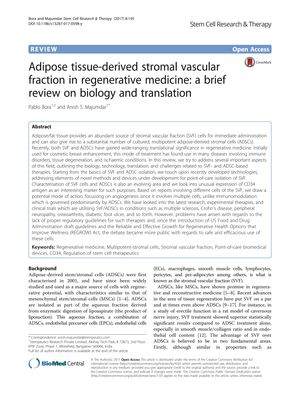Adipose Tissue-Derived Stromal Vascular Fraction in Regenerative Medicine: A Brief Review on Biology and Translation
June 2017
in “
Stem Cell Research & Therapy
”

TLDR Fat tissue-derived cells show promise for repairing body tissues, but more research and regulation are needed for safe use.
In the 2017 review, Bora and Majumdar explored the potential of adipose tissue-derived stromal vascular fraction (SVF) in regenerative medicine, emphasizing its diverse cellular composition and the ease of obtaining these cells compared to adipose-derived stromal cells (ADSCs). They discussed the challenges of SVF isolation, including the need for specialized infrastructure and concerns about using collagenase, suggesting mechanical agitation as a non-enzymatic alternative. The review highlighted the development of automated devices for SVF isolation and the importance of the CD34 antigen as a marker for characterizing SVF cells. Despite the promise of SVF in treating various conditions, the authors stressed the necessity for regulatory guidelines to ensure the safe and effective use of these cells. They also examined the molecular markers and roles of ADSCs and endothelial cells in angiogenesis, the transient nature of CD34 expression, and the influence of hypoxia on stemness. The review concluded with a discussion on the clinical applications of SVF and ADSCs, and the regulatory landscape for "fat stem cell" therapies, underscoring the need for further research into the properties and functions of ADSCs.


